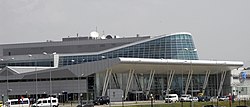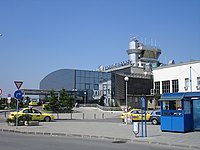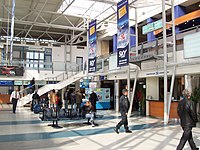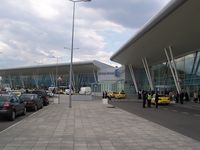Sofia airport
| Sofia Airport Летище София 16 Transportna Aviacionna Basa (16th TrAB) |
|
|---|---|

|
|
| Characteristics | |
| ICAO code | LBSF |
| IATA code | SOF |
| Coordinates | |
| Height above MSL | 531 m (1742 ft ) |
| Transport links | |
| Distance from the city center | 10 km east of Sofia |
| train | Metro line 1 |
| Local transport | Bus 84 and 384 (30 minutes to the center) |
| Basic data | |
| opening | 1935 |
| operator | Sofia Airport EAD |
| Terminals | 2 |
| Passengers | 7,089,389 (2019) |
| Air freight | 23,987 t (2019) |
| Flight movements |
61,371 (2019) |
| Capacity ( PAX per year) |
up to 5,000,000 |
| Start-and runway | |
| 09/27 | 3600 m × 45 m asphalt |
The Sofia Airport ( Bulgarian Летище София / Letischte Sofia), formerly Airport Sofia-Vrazhdebna (Bulgarian: Летище София-Враждебна, Letischte Sofija-Wraschdebna), named after the north past the airport settlement, is a Bulgarian airport in Sofia . It is the most important airport in the country and the base of the Bulgarian airline Bulgaria Air (FB / LZB), the Irish Ryanair (FR / RYR) and the Hungarian WizzAir (W6 / WZZ). When it opened in 1935, Sofia Airport was the first major international airport in Bulgaria. In 2017 it was used by 6.5 million passengers.
Bulgaria also has international airports in Varna , Burgas , Plovdiv and Gorna Orjachowitsa , which play an important role in tourism.
Sofia Airport is also used for military purposes. The Bulgarian air force used it as a military airfield Wraschdebna or 16th transport air base , 16-ta transportna awiazionna basa , 16-та транспортна авиобаза (16th TrAB, 16-та ТрАБ).
From July 22, 2020, the concessionaire for Sofia Airport will be the Sof Connect consortium, which consists of the French investment fund Meridiam (99%) and the Austrian Strabag (1%). The concession period is 35 years. The airport operator for the first 12 years of the concession period will be Munich Airport International.
Civil use
On the airport grounds - between Terminals 1 and 2 - there is a large facility for the maintenance, overhaul and repair of aircraft operated by Lufthansa Technik .
In recent times, the airport has encountered size bottlenecks and was no longer able to cope with today's number of passengers and aircraft. For this reason, the decision was made to expand the existing airport after excluding many different options that would have been located up to 70 km from Sofia. For this reason , a second terminal was opened on December 27, 2006, just in time for Bulgaria joining the EU .
Transport links
The airport is 12 km east of downtown Sofia and can be reached via the old airport expressway. In the near future, the new Terminal 2 in particular will also be connected to the city center via a new motorway.
The private taxis offered by dubious taxi companies in the reception halls usually demand exorbitant tariffs that are ten times higher than the usual rates . Sofia Airport is endeavoring to combat this problem with specially set up taxi counters.
Three bus routes connect the airport with Sofia's city center. Line 84 runs between the main building of Sofia University and Terminal 2, line 184 runs between the main building of Sofia University and Terminal 1, every 10 to 15 minutes between 4:30 and 23:30. The journey time is approx. 35 minutes. Line 384 connects Terminal 2 with the Druzhba residential complex every 15 to 30 minutes between 5 a.m. and 11 p.m.
Since April 2, 2015, Terminal 2 has been directly connected to Sofia subway line 1. The underground station is located above ground to the east of the terminal building and can be reached via a short pedestrian bridge. The subway runs every day between 5:30 am and midnight, and the journey to the Serdika central transfer station takes 28 minutes.
A free bus runs every 30 minutes between Terminal 1 and Terminal 2 between 5 a.m. and 11 p.m., the stops are signposted. During the rest of the time, a trip can be requested by phone or at the information desk.
Destinations
From the Sofia airport mainly destinations in the German, English and Spanish regions are served. In German-speaking countries, there are flights to Basel , Berlin-Tegel , Berlin-Schönefeld , Dortmund , Frankfurt , Friedrichshafen , Geneva , Hamburg , Karlsruhe / Baden-Baden , Cologne / Bonn , Memmingen , Munich , Nuremberg , Vienna and Zurich .
The connections to London, Berlin, Frankfurt, Munich, Vienna and Zurich allow connecting flights to Asia , America and Africa to be put together.
expansion
A new runway was opened in Sofia in mid-2006 and construction began in mid-2005. In terms of length, it was also designed for large, modern aircraft such as the Airbus A380 . The old runway is now used as a connection route to the new one. In addition, the Austrian construction company Strabag built a new terminal building by the end of 2006. Originally, a new motorway was also planned, which should be completed in the course of 2007 and primarily serve for the new terminal building. The aim was to connect the terminal with the old airport expressway and thus with the old terminal and downtown Sofia faster and more comfortably. However, the construction was canceled for lack of money, completion is not foreseeable in the near future.
Terminal 1
Terminal 1 opened in 1935 and served as both a national and international terminal from the start. It was the first large terminal building in Bulgaria and a real traffic sensation at the time.
The old terminal is at the end of the old airport road and still forms the core of a constantly expanding industrial area. In its vicinity there are many buildings belonging to the airport as well as a large number of facilities and complexes that are directly or indirectly related to aviation.
The terminal building has seven exits through which passengers are brought to their aircraft by shuttle buses. Terminal 1 also has 20 check-in counters.
Terminal 1 has a classic dichotomy, which can be found mainly at small airports in Eastern Europe. The departure and arrival areas are in close proximity to each other, but are completely separate from each other.
There is an open, uncovered parking lot in front of the terminal, which is now only used by comparatively few vehicles.
The terminal has been rebuilt and expanded several times. After the collapse of the communist regime in Bulgaria, the very strict border controls at that time when entering and leaving the country were dismantled or rebuilt according to western standards.
Most recently, the terminal received a new front end of the check-in area, where the airlines' information desks are now also located. It is a modern glass-steel construction. The pick-up area of the arrival building was rebuilt in the same style. However, these last renovations were almost ten years ago.
Since April 2007 the old terminal has only been used for flights by low-cost airlines.
Terminal 2
Terminal 2 was built until November 2006 and officially opened on December 27, 2006. The first aircraft to park at the terminal was a Bulgaria Air machine (flight number FB 408), which symbolically arrived from Brussels .
The terminal building and all associated facilities are located on a previously unused area that was fallow until construction began. This presented the architects Fröhlich and Locher with a difficult task, as all the requirements for the new building had to be prepared first.
The terminal was built for around 135 million euros and is one of the largest projects in Bulgaria that was partially financed by funds from the EU-ISPA program. This price includes not only the costs of the new terminal building, but also the additional newly built aircraft parking positions, an extension of the existing parking positions and the new taxiways that connect the new terminal with the old building and the two runways.
The new terminal is significantly larger than the old one and is located to the east of it. In addition to five shuttle bus exits (one of which is separate from the others, for national routes and therefore without passport control), it has seven passenger boarding bridges or fingers, so-called gates, and is thus Bulgaria's first airport terminal where passengers are no longer can only be brought to your aircraft via shuttle buses. It also has 34 check-in counters and has been built on a total area of almost 50,000 m².
An underground car park on four floors and a capacity of 820 parking spaces was also built. It should do justice to today's passenger car and bus capacities of airport visitors.
Terminal 2 has a modern structure. In contrast to the old terminal building, the contemporary layout means that the entire public area can be accessed. The facilities of the new terminal are spread over three levels. In the main area there is a large atrium, which, like the rest of the building, is surrounded by large panoramic windows and is thus flooded with daylight.
Since Terminal 2 is Bulgaria's first terminal building on several passenger floors, it was particularly important for the architects to make each level accessible to disabled people. For this reason, all floors of the terminal and the underground floors of the parking garage are connected by elevators, and on the above-ground terminal floors by escalators.
The electricity for the terminal building and its surrounding facilities is largely obtained from solar cells on the roof of the building. In this way, the terminal is operated in a very energy-saving and environmentally friendly way.
The new passenger terminal is designed for a passenger capacity of approximately 2000 per hour and 2.6 million per year. At the same time, 26,000 tons of freight are to be handled in it.
The converted apron in front of Terminal 2 was also opened in summer 2009. A landscape park, an amphitheater for concerts, an observation tower and an artificial lake were opened on an area of around 145 hectares. The lake is connected to the nearby Iskar River by a pumping station . The terminus of the Sofia Metro was built on the site between the terminal and the park in April 2015 .
The new terminal has been used for flights by national and international scheduled airlines since April 2007.
Incidents
- On November 22, 1975 an Antonov An-24B of the Balkan Bulgarian Airlines ( aircraft registration LZ-ANA ) was de-iced for a flight to Varna in snowfall . After the machine rolled to the start, the start was delayed because the snow on the runway was cleared by winter service vehicles . During this time, the effective duration of the de-icing carried out passed. When the runway was cleared again and the machine was given take-off clearance, it did not gain height after take-off and fell behind the runway into the ditch of the Iskar River . Of the 45 occupants of the machine, the first officer and two passengers died who drowned in the river after the impact (see also the flight accident involving the Antonov An-24 LZ-ANA of the Balkan Bulgarian Airlines ) .
- On January 10, 1984, a Tupolev Tu-134 of Balkan Bulgarian Airlines (LZ-TUR) launched from Berlin-Schönefeld Airport collided with a power line while approaching Sofia Airport in heavy snowfall after the pilots had flown below the decision height despite the lack of visibility . The machine crashed four kilometers from the runway into the cowshed of a cooperative farm. In this renewed CFIT ( Controlled flight into terrain ), all 45 passengers and all five crew members were killed. Later revelations about the accident revealed that the captain of the aircraft was urged by an inspector from the Bulgarian State Aviation Inspectorate, who got on the aircraft shortly before departure, to carry out the landing blind (see also the flight accident of the Tupolev Tu-134 LZ-TUR the Balkan Bulgarian Airlines ) .
Military use
There are three different associations based in the military sector.
- the transport squadron of the air force 1/16-ta transportna awioeskadrila of the 16th TrAB, equipped with various transport and liaison aircraft
- some liaison aircraft of the headquarters of the Air Defense Corps (Korpus protiwowsduschna otbrana, Корпусът противовъздушна отбрана)
- the “flight readiness” of the Ministerstwo na wtreschnite raboti (Министерство на вътрешните работи), which is equipped with various aircraft and helicopters
Individual evidence
- ↑ a b c Statistic information about International Airports in Republic of Bulgaria. In: caa.bg. Aviation Authority of Bulgaria (CAA), accessed on May 24, 2020 (English).
- ↑ Sofia Airport: Passenger Numbers Sofia Airport. (PDF) In: company website. 2017, accessed October 6, 2018 (Bulgarian).
- ↑ Portrait: Lufthansa Technik Sofia - Lufthansa Technik AG. Retrieved October 5, 2018 (German).
- ↑ Sofia Airport on Airport Desk
- ↑ sofia-airport.bg on the website of Sofia Airport
- ↑ На 10 януари 1984 г., самолет на "Балкан" се разбива край София , Dnewnik.bg January 9, 2009 (Bulgarian), accessed July 20, 2020.
Web links
- Airport data on World Aero Data ( 2006 )
- Airport data in the Aviation Safety Network (English)
- sofia-airport.bg Official website of the airport (bulg./engl.)
- Fröhlich & Locher civil engineers Official website of the architectural office (Terminal 2)











